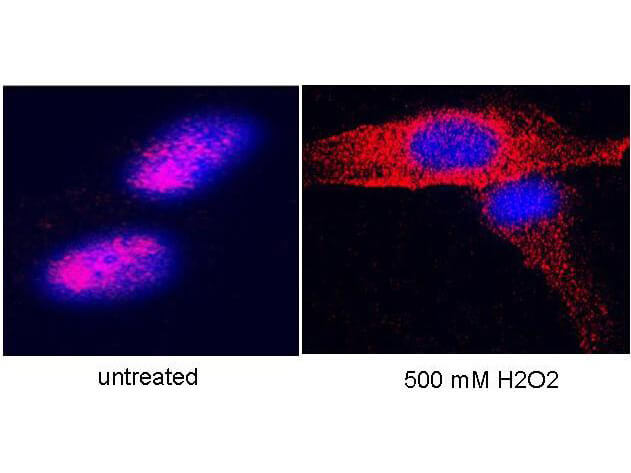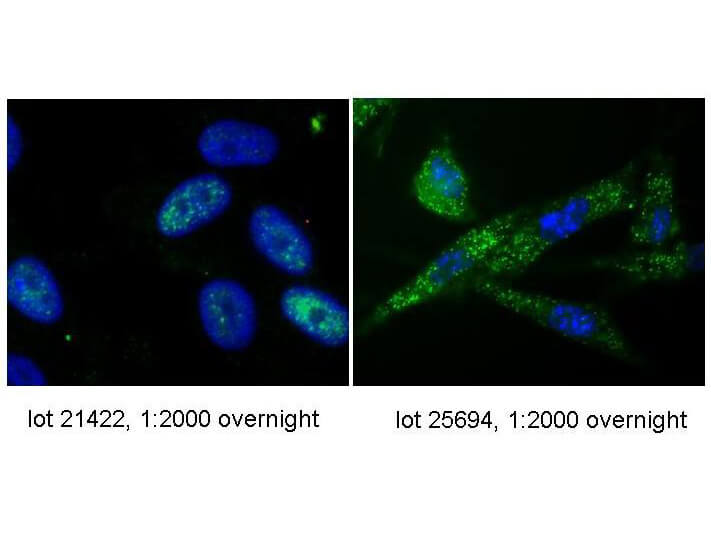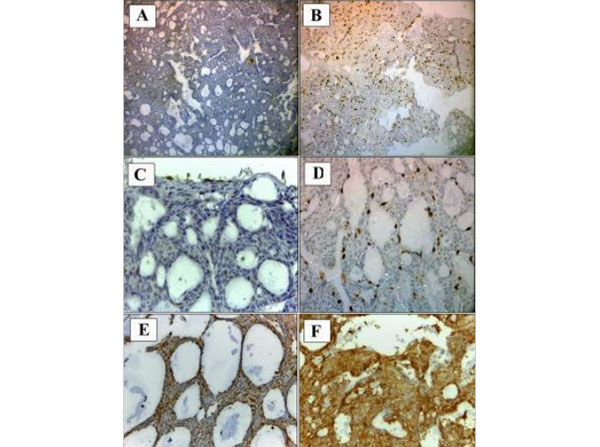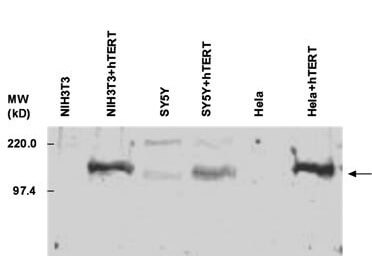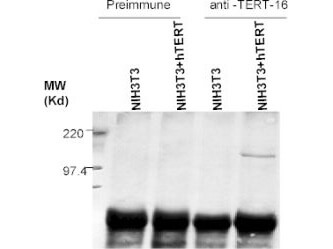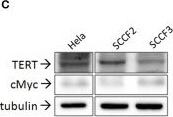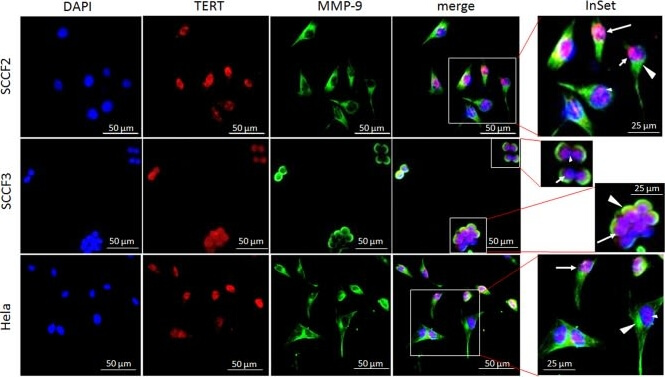Telomerase catalytic subunit Antibody
Rabbit Polyclonal
44 References
600-401-252S
600-401-252
25 µL
100 µg
Liquid (sterile filtered)
Liquid (sterile filtered)
WB, ELISA, IHC, IF, IP, ChIP, FISH, Multiplex
Human
Rabbit
Shipping info:
$50.00 to US & $70.00 to Canada for most products. Final costs are calculated at checkout.
Product Details
Anti-Telomerase catalytic subunit (RABBIT) Antibody - 600-401-252
rabbit anti-TERT antibody, rabbit anti-Telomerase catalytic subunit antibody, hTERT, Telomerase reverse transcriptase, HEST2, Telomerase-associated protein 2, TP2, EST2, TCS1, TRT
Rabbit
Polyclonal
IgG
Target Details
TERT - View All TERT Products
Human
Conjugated Peptide
This affinity purified antibody was prepared from whole rabbit serum produced by repeated immunizations with a synthetic peptide corresponding to a region near the carboxy terminal end of hTERT (accession number AF018167).
Affinity Purified Anti-hTERT Antibody was prepared from monospecific antiserum by immunoaffinity chromatography using synthetic peptide coupled to agarose beads. Assay by immunoelectrophoresis resulted in a single precipitin arc against anti-Rabbit Serum. Although it has been reported that this antibody reacts with mouse TERT (mTERT) (see Drissi, et al. 2001), the binding to mTERT is considerably weaker and less specific than the binding to hTERT (not shown).
Application Details
ELISA, IF, IP, WB
ChIP, FISH, IHC, Multiplex
- View References
Anti-Telomerase catalytic subunit antibody has been tested for use in ELISA, immunoblotting, immunoprecipitation, and immunofluorescence microscopy. In these assays, the antibody detects ectopically-expressed hTERT and high levels of endogenous hTERT. A SY5Y cell nuclear extract can be used as a positive control. This antibody primarily detects hTERT, but several non-specific bands appear on immunoblots. In immunofluorescence microscopy assays, staining with anti-TERT-16 was specific to the nuclei of cells with ectopic TERT expression. In immunoblot assays, whole cell or nuclear extracts were loaded at a concentration of 100 µg protein per well. A working dilution of 1:500 anti-TERT antibody was used followed by a 1:3,000 dilution of HRP goat anti-rabbit IgG as the secondary antibody. For immunofluorescence microscopy staining, a working dilution of 1:500 was used followed by a 1:200 dilution of rhodamine-conjugated donkey anti-rabbit IgG as a secondary antibody. Immunoprecipitation was performed using 20 µL of protein A beads and 2 µL of the anti-TERT serum per 1mg protein from cell lysate. A working dilution of 1:500 is also suggested for immunohistochemistry. To detect TERT, fix cells in 2% paraformaldehyde (in PBS) for 10'. Wash the slides twice in PBS for 5' each. Permeabilize the cells in 0.5% NP-40 for 10'. Wash as before in PBS. Block the cells using PBG buffer (0.2% cold water fish gelatin (Sigma G-7765) and 0.5% BSA in PBS) for 20' at room temperature. Incubate in primary antibody (diluted in PBG) for 1-2 hours at RT or overnight at 4ºC. Wash the slides three times in PBG for 5' each. Incubate with secondary antibody (diluted in PBG) for 1 hour at RT in the dark. Wash the slides three times in PBG for 5' each. Mount in DAPI-containing medium.
Formulation
1.0 mg/mL by UV absorbance at 280 nm
0.02 M Potassium Phosphate, 0.15 M Sodium Chloride, pH 7.2
0.01% (w/v) Sodium Azide
None
Shipping & Handling
Dry Ice
Store vial at -20° C prior to opening. Aliquot contents and freeze at -20° C or below for extended storage. Avoid cycles of freezing and thawing. Centrifuge product if not completely clear after standing at room temperature. This product is stable for several weeks at 4° C as an undiluted liquid. Dilute only prior to immediate use.
Expiration date is one (1) year from date of receipt.
Telomerase is a reverse transcriptase that adds telomeric repeats (TTAGGG)n to chromosomal ends, compensating for the telomere shortening that occurs with DNA replication. In normal human somatic cells, telomerase is repressed and telomeres progressively shorten, leading to limited lifespan and senescence. Reactivation of telomerase activity is associated with human cancer and cell immortalization. Approximately 85% of human cancers, including breast, prostate, stomach, bladder, colon, and liver cancer, have telomerase activity, whereas most normal somatic cells do not. The specificity of telomerase to human cancer has led to investigations of telomerase activity and expression as a tumor marker. For example, the presence of telomerase activity in human urine has been identified as a marker for human bladder carcinoma. Human telomerase consists of three major subunits: a catalytic protein subunit called hTERT (for human Telomerase Reverse Transcriptase), a template RNA called hTR, and telomerase-associated protein (TEP-1). TERT and hTR are minimally required to reconstitute telomerase activity in vitro. In human cells, hTR is constitutively expressed. TERT transcription is a primary mechanism for regulation of telomerase activity.
Alabiad MA. et al. (2024). Evaluation of Some Prognostic Biomarkers in Human Papillomavirus-Related Multiphenotypic Sinonasal Carcinoma. Iran J Med Sci.
Applications
IHC, ICC, Histology
Muranyi, W et al. (2022). Immortalized human choroid plexus endothelial cells enable an advanced endothelial-epithelial two-cell type in vitro model of the choroid plexus. IScience
Applications
WB, IB, PCA; IF, Confocal Microscopy
Gómez-Ferrer, M et al. (2021). HIF-1α and Pro-Inflammatory Signaling Improves the Immunomodulatory Activity of MSC-Derived Extracellular Vesicles. International Journal of Molecular Sciences
Applications
WB, IB, PCA
Lagnado, A et al. (2021). Neutrophils induce paracrine telomere dysfunction and senescence in ROS-dependent manner. The Embo Journal
Applications
Other
Chatterjee, S et al. (2021). Telomerase therapy attenuates cardiotoxic effects of doxorubicin. Molecular Therapy : the Journal of the American Society of Gene Therapy
Applications
WB, IB, PCA
Reilly CR et al. (2021). The clinical and functional effects of TERT variants in myelodysplastic syndrome. Blood.
Applications
WB, IB, PCA
Gissi C. et al. (2020). Extracellular vesicles from rat-bone-marrow mesenchymal stromal/stem cells improve tendon repair in rat Achilles tendon injury model in dose-dependent manner: A pilot study. PLoS One
Applications
WB, IB, PCA
Altamura G et al. (2020). Telomerase Reverse Transcriptase (TERT) Expression, Telomerase Activity, and Expression of Matrix Metalloproteinases (MMP)-1/-2/-9 in Feline Oral Squamous Cell Carcinoma Cell Lines Associated With Felis catus Papillomavirus Type-2 Infection. Front Vet Sci.
Applications
IHC, ICC, Histology; WB, IB, PCA; Multiplex Assay
Gissi, C et al. (2020). Extracellular vesicles from rat-bone-marrow mesenchymal stromal/stem cells improve tendon repair in rat Achilles tendon injury model in dose-dependent manner: A pilot study. PloS One
Applications
WB, IB, PCA
Bussiere FI et al. (2019). DNA hypermethylation downregulates telomerase reverse transcriptase (TERT) during H. pylori-induced chronic inflammation. J Oncol.
Applications
IHC, ICC, Histology
Perera, ON et al. (2019). Telomerase promotes formation of a telomere protective complex in cancer cells. Science Advances
Applications
IF, Confocal Microscopy; Proximity Ligation Assay (PLA)
Delfarah, A et al. (2019). Inhibition of nucleotide synthesis promotes replicative senescence of human mammary epithelial cells. The Journal of Biological Chemistry
Applications
WB, IB, PCA
Hugdahl et al. (2018). Prognostic impact and concordance of TERT promoter mutation and protein expression in matched primary and metastatic cutaneous melanoma. British Journal of Cancer
Applications
IHC, ICC, Histology
Schmidt et al. (2018). Dynamics of human telomerase recruitment depend on template- telomere base pairing. Molecular Biology of the Cell
Applications
WB, IB, PCA
Kabacik et al. (2018). Epigenetic ageing is distinct from senescence-mediated ageing and is not prevented by telomerase expression. Aging
Applications
WB, IB, PCA
Bernal et al. (2018). Generation of Immortalised But Unstable Cells after hTERT Introduction in Telomere-Compromised and p53-Deficient vHMECs. International Journal of Molecular Sciences
Applications
WB, IB, PCA
Li et al. (2017). The Werner Syndrome Helicase Coordinates Sequential Strand Displacement and FEN1-Mediated Flap Cleavage during Polymerase δ Elongation. Molecular and Cellular Biology
Applications
WB, IB, PCA
Eitan et al. (2016). Excitotoxic and Radiation Stress Increase TERT Levels in the Mitochondria and Cytosol of Cerebellar Purkinje Neurons. The Cerebellum
Applications
IHC, ICC, Histology; WB, IB, PCA
Hong et al. (2016). Telomerase activates transcription of cyclin D1 gene through an interaction with NOL1. Journal of Cell Science
Applications
IF, Confocal Microscopy; IP, Co-IP; WB, IB, PCA
Vanderstraeten et al. (2016). In Vitro Assessment of the Expression and T Cell Immunogenicity of the Tumor-Associated Antigens BORIS, MUC1, hTERT, MAGE-A3 and Sp17 in Uterine Cancer. International Journal of Molecular Sciences
Applications
IHC, ICC, Histology
Qing H et al. (2016). Differential regulation of telomerase reverse transcriptase promoter activation and protein degradation by histone deacetylase inhibition. J Cell Physiol.
Applications
IHC, ICC, Histology
Jeong et al. (2015). Akt-mediated phosphorylation increases the binding affinity of hTERT for importin α to promote nuclear translocation. Journal of Cell Science
Applications
WB, IB, PCA
Fiorito F et al. (2014). Modulation of telomerase activity, bTERT and c-Myc induced by 2, 3, 7, 8-tetrachlorodibenzo-p-dioxin during Bovine Herpesvirus 1 infection in MDBK cells. Toxicol In Vitro.
Applications
WB, IB, PCA
Radan L et al. (2014). Microenvironmental regulation of telomerase isoforms in human embryonic stem cells. Stem Cells Dev.
Applications
IF, Confocal Microscopy; WB, IB, PCA
Gonzalez OG et al. (2014). Telomerase stimulates ribosomal DNA transcription under hyperproliferative conditions. Nat Commun.
Applications
ChIP; WB, IB, PCA
Theurillat, JPP et al. (2014). Prostate cancer. Ubiquitylome analysis identifies dysregulation of effector substrates in SPOP-mutant prostate cancer. Science (New York, N.Y.)
Applications
WB, IB, PCA
Lee J et al. (2013). Upregulation of Nrf2 expression by human cytomegalovirus infection protects host cells from oxidative stress. J Gen Virol.
Applications
IF, Confocal Microscopy
Eitan E et al. (2012). Novel telomerase‐increasing compound in mouse brain delays the onset of amyotrophic lateral sclerosis. EMBO Mol Med.
Applications
WB, IB, PCA
Ponsot E et al. (2012). Telomere length and regulatory proteins in human skeletal muscle with and without ongoing regenerative cycles. Exp Physiol.
Applications
WB, IB, PCA
Eitan E et al. (2012). Telomerase expression in adult and old mouse Purkinje neurons. Rejuvenation Res.
Applications
WB, IB, PCA
Samba-Louaka A et al. (2012). Role for telomerase in Listeria monocytogenes infection. Infect Immun.
Applications
WB, IB, PCA
Gizard F et al. (2011). Telomerase activation in atherosclerosis and induction of telomerase reverse transcriptase expression by inflammatory stimuli in macrophages. Arerioscler Thromb Vasc Biol.
Applications
WB, IB, PCA
Georgopoulos NT et al. (2011). Immortalisation of normal human urothelial cells compromises differentiation capacity. Eur Urol.
Applications
IHC, ICC, Histology
Fiorito F et al. (2011). 2, 3, 7, 8-tetrachlorodibenzo-p-dioxin induced autophagy in a bovine kidney cell line. Toxicology
Applications
WB, IB, PCA
Abreu E et al. (2010). TIN2-tethered TPP1 recruits human telomerase to telomeres in vivo. Mol Cell Biol.
Applications
ISH, FISH; WB, IB, PCA
Tuntiwechapikul W et al. (2010). Ginger extract inhibits human telomerase reverse transcriptase and c-Myc expression in A549 lung cancer cells. J Med Food.
Applications
WB, IB, PCA
Liu, S. et al. (2010). Telomerase as an important target of androgen signaling blockade for prostate cancer treatment. Molecular Cancer Therapeutics
Applications
WB, IB, PCA
Fabricius EM et al. (2009). Localization of telomerase hTERT protein in frozen sections of basal cell carcinomas (BCC) and tumor margin tissues. Int J Oncol.
Applications
IHC, ICC, Histology
Jakupciak JP et al. (2009). Improved methods and standards for telomerase detection: quantitative histopathology using antibody staining. Biotech Histochem.
Applications
IHC, ICC, Histology
Fabricius EM et al. (2009). Immunohistochemical determination of the appropriate anti-hTERT antibodies for in situ detection of telomerase activity in frozen sections of head and neck squamous cell carcinomas and tumor margin tissues. Int J Oncol.
Applications
IHC, ICC, Histology
Oh W et al. (2009). PML-IV functions as a negative regulator of telomerase by interacting with TERT. J Cell Sci.
Applications
IF, Confocal Microscopy
Tichon A et al. (2009). Telomerase activity and expression in adult human mesenchymal stem cells derived from amyotrophic lateral sclerosis individuals. Cytotherapy
Applications
WB, IB, PCA
Ahmed S. et al. (2008). Telomerase does not counteract telomere shortening but protects mitochondrial function under oxidative stress. J Cell Sci.
Applications
IF, Confocal Microscopy
Chau MN et al. (2007). Physiologically achievable concentrations of genistein enhance telomerase activity in prostate cancer cells via the activation of STAT3. Carcinogenesis.
Applications
WB, IB, PCA
This product is for research use only and is not intended for therapeutic or diagnostic applications. Please contact a technical service representative for more information. All products of animal origin manufactured by Rockland Immunochemicals are derived from starting materials of North American origin. Collection was performed in United States Department of Agriculture (USDA) inspected facilities and all materials have been inspected and certified to be free of disease and suitable for exportation. All properties listed are typical characteristics and are not specifications. All suggestions and data are offered in good faith but without guarantee as conditions and methods of use of our products are beyond our control. All claims must be made within 30 days following the date of delivery. The prospective user must determine the suitability of our materials before adopting them on a commercial scale. Suggested uses of our products are not recommendations to use our products in violation of any patent or as a license under any patent of Rockland Immunochemicals, Inc. If you require a commercial license to use this material and do not have one, then return this material, unopened to: Rockland Inc., P.O. BOX 5199, Limerick, Pennsylvania, USA.

